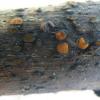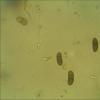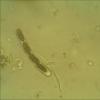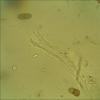
11-03-2012 12:06
bonjour j'ai trouvé cet asco sur une barriere con

11-03-2012 01:12
Roland LabbéBonjour !Voici une planche et une photo macro d'un

19-07-2009 17:42
Mireille LenneBonjour, Toujours Sporormiella mais à 4 cellul

10-03-2012 15:44
Bonjour, Je viens de faire une récolte étonnante

09-03-2012 13:34
Mauricio MarinHiCollected on tree of shore. Espora 18-20 (21) x

10-03-2012 13:17
Aouali SouhilaBonjour,Je tente d'arriver au genre, mais sans suc
Aide asco Mayotte
maurice pelissier,
11-03-2012 12:06
j'ai trouvé cet asco sur une barriere constituée de branche de manguier disques de 1 à 4mm spores brunes septées paraphyses etranglées
avez vous une idée ??
Christian Lechat,
11-03-2012 13:06

Re : Aide asco Mayotte
Bonjour Maurice,
je pense que tu peux voir ça ici: http://www.ascofrance.fr/recolte/968/dothideomycetes-patellariales-patellariaceae-rhytidhysteron-rufulum
Cordialement,
Christian
je pense que tu peux voir ça ici: http://www.ascofrance.fr/recolte/968/dothideomycetes-patellariales-patellariaceae-rhytidhysteron-rufulum
Cordialement,
Christian
maurice pelissier,
12-03-2012 20:18
Re : Aide asco Mayotte
bonjour christian
Merci de ta réponse j'ai vu que tu as déterminé une recolte de guadeloupe est ce que ce genre est typiquement tropical ?? et penses tu que ma recolte soit rhytidhysteron-rufulum? ou une espèce du genre rhytidhysteron???
Merci de ta réponse j'ai vu que tu as déterminé une recolte de guadeloupe est ce que ce genre est typiquement tropical ?? et penses tu que ma recolte soit rhytidhysteron-rufulum? ou une espèce du genre rhytidhysteron???
Christian Lechat,
12-03-2012 20:43

Re : Aide asco Mayotte
Bonsoir Maurice,
ce pourrait-être R. rufulum effectivement, pour le confirmer, il faudrait plus de renseignements microscopiques.
Cordialement,
Christian
ce pourrait-être R. rufulum effectivement, pour le confirmer, il faudrait plus de renseignements microscopiques.
Cordialement,
Christian
Chris Yeates,
12-03-2012 23:34

Re : Aide asco Mayotte
Bonsoir Maurice
there is a useful webpage here: http://www.eboehm.com/id62.html?
following the key there it does seem that you have R. rufulum
amitiés
Chris
there is a useful webpage here: http://www.eboehm.com/id62.html?
following the key there it does seem that you have R. rufulum
amitiés
Chris







